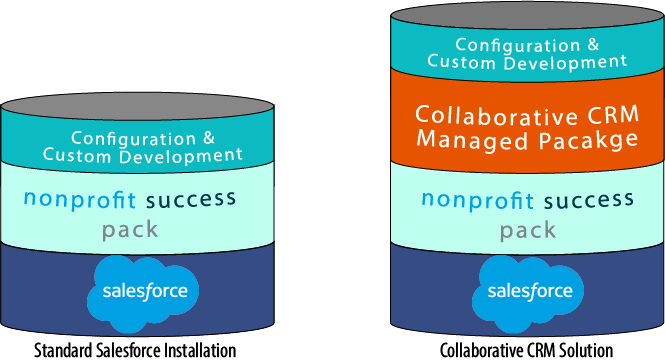Serving a nonprofit network with a Salesforce Managed Package Collaborative CRM Platform
Homekeeper, Breakthrough Collaborative and United Philanthropy Forum are examples of the increasing number of affiliated nonprofit organizations or chapter networks looking to collaborate and better align their efforts using Collaborative CRM platforms on Salesforce. This post builds on the introduction to Collaborate CRM Platforms to cover how these National nonprofits are building, releasing and supporting Managed Packages, a feature of Salesforce typically used by App providers to distribute product to customers.
With a managed package each affiliated organization acquires their own separate Salesforce account. The Collaborative CRM is produced effectively as an ‘App’ that gets installed in each account. Once installed, each organization has the full power of the Collaborative CRM platform and can further customize their own account around their specific needs.
What is important is that a standard starting point is picked for the platform base-layer. Everyone gets this same starting point to add their own configuration choices, a starting point that can be light-years ahead of where they’d be if developing this feature set on their own.
Functionality Comparison

Solve Shared Challenges, Automate Common Processes
You can’t, nor should you, solve for every problem of every organization on the platform. If you do, quickly the solution will be a sprawling mess, less usable, more costly and less functional for core needs. Instead focus on the the core set of shared challenges, processes and benefits. Look for the ways in which organizations align and identify the most important things they do.
It is expected that once an organization has their platform in place addition configuration or enhancements will be required in their personal instance to maximize the potential of the solution for the group. This is one of the great values of the Salesforce platform. With Salesforce.com’s focus on clicks-not-code, non-technical team members can make modifications with training on basic Salesforce Administration.
What you can and should do is make the features of the package as configurable as possible for the local admin. That means ensuring that wherever possible, the package enables an admin to choose fields on a form via a field set, set field mappings for integrations via Custom MetaData, and alter the design of public facing pages to enable them to add their own text, colors and images. Advances in the Lightning component framework increases that ability. Chapters get the benefit of shared development costs, while maintaining many of the abilities to configure the user experience and workflow.
It is common that during the onboarding process for a new affiliate, further basic customizations are baked into the process such as for picklist values, security settings, and other areas that nearly all affiliates will have to modify. Since its expected, make it a part of the process and the onboarding gets easier.
With Salesforce’s open architecture, new features can be developed and third-party apps integrated by an in-house developer or by tapping the enormous partner network available through Salesforce’s Appexchange. These are more significant endeavors but it’s often appropriate to take this route for business lines that aren’t shared by other affiliates or with related software that is not widely used.
Our Collaborative CRM has been a huge success! We maintain a collective system with all the related benefits while allowing any participant to develop/customize individually or partner with one, several, or all system partners to expand the scope of their system.
Collaboration and Professional Development
Good communication among the collaborative group is key when considering enhancements to the system. Affiliates can, for the most part, do what they want with their Salesforce but in many cases tapping back into the collaborative group is the best route. If an affiliate has a new need to be met by the system there is a decent chance that other affiliates are experiencing the same need. One organization might already have solved the problem and can provide a how-to for others. If the need is shared across enough affiliates it likely should be developed into a future release. Collaboration is so critical, United Philanthropy Forum bakes it into their requirements for participation. Before joining the platform, member affiliates are asked:
- Do you have sufficient staffing to join this collaborative?
- Do you have sufficient budget to participate?
- Can you make a commitment to participate in this learning community?
- Can you respect the community norms of your fellow co-investors? The Forum and its members are not vendors. Everyone is an equal partner in the collaborative.
- Are you comfortable sharing with your fellow co-investors about your technology needs in an atmosphere of transparent collegial cooperation?
- Can you assume responsibility for ongoing, routine maintenance and system updates?
- Can you commit to staying informed about enhancements made to the project? Members are constantly innovating on behalf of the collaborative. You are not required to adopt any enhancements, but you are expected to stay informed so that you can choose whether or not to opt-in.
With each affiliate or chapter having their own Salesforce its important they each acknowledge and own the responsibility that comes with having a full-blown CRM. Typically this starts with the local affiliate selecting a team member to be the Salesforce Administrator in an official capacity. Although not necessarily a full-time job this is an important role that should officially be assigned as any other job with goals, a professional development budget and appropriate time allocated for this person to be successful. Primary responsibilities include:
- Local configuration of the affiliate’s Salesforce
- Installing/configuring new package upgrades
- Training and supporting staff on Salesforce
- Liasing with other Salesforce Admins from the network on best practices, answering questions and contributing/commenting on ideas for future enhancements to the Collaborative CRM platform.
We’ve seen a very clear staff development path with our technology platform. This is confirmed by so many of us getting Salesforce certification. Our member organizations are seeing value and in most cases provide financial support for this professional development.
With economies of scale and support from the network we’ve seen that for many chapters or affiliates this is the first time they have owned a CRM! Previously they may have been inputting data into spreadsheets or multiple systems dedicated by funders or other partners. For them stepping up to the responsibilities and benefits of a CRM is indicative of their commitment to elevate their overall efforts.
Extendable
One great value of the Managed Package route is its sustainability. This path uses the Integrated Software Vendor (ISV) program by Salesforce.com and leverages functionality that allows for new releases to be distributed to the group. The package is not static; rather it can be consistently improved over time with those improvements being available to all. Some tips to do this successfully are:
- Create a mechanism for cataloguing minor suggestions, bugs, issues to solve and major new functionality to develop.
- Have a committee that reviews the catalogue and prioritizes items on the roadmap
- Maintain a relationship with a developer or consultant that has expertise with managed packages to scope out those items and build these enhancements into a new release
- Carefully roll-out each new release with good documentation and associated training materials. If it’s critical for affiliates to upgrade then follow-up with them and put a deadline in place.
- Develop relationships in the Power of Us Hub with other organizations with Collaborative CRMs to solicit feedback and share lessons learned.
As Holly Havelka, Salesforce Administrator at Breakthrough Collaborative puts it, “We are going into this initiative with a ‘partner’ mindset and the belief that we are providing a ‘software’ solution to our Affiliates. What I’d ask to other organizations considering this route is, ‘are you ready, setup and committed to become a software provider?’”
Economies of Scale
Obviously it takes collaboration and budget both at startup and on an ongoing basis to keep this up. These resources though are investments each affiliate would be making as a standalone entity; doing it collaboratively provides better results at a lower cost of both time and money.
We’ve participated in (United Philanthropy Forum’s) Collaborative (CRM) for many years and saved tens of thousands of dollars while gaining access to more technology and expertise than we could ever afford or handle independently. Our network has an unprecedented level of collaboration where we see colleagues, now friends, helping each other across the country every day. It is incredibly rewarding to be part of this collaborative!
That being said, this route takes commitment from all involved most importantly from the central organization that owns the package. Most notably, staff capacity is needed to lead this project, support chapters/affiliates and drive collaboration.
Pooling Metrics
With managed packages, the opportunity exists to pool data across organizations to create industry metrics. Obviously, this would need to be an opt-in process amongst collaborators and a decent amount of attention needs to be paid to how the data is extracted from each organization and centralized for reporting but the architecture is in place to make this seamless and automated. With the Managed Package route, parts of the application central to network-wide measurements can be locked down to ensure easy and accurate reporting.
Homekeeper, a project of Grounded Solutions, is a great example where participating organizations can see their program and performance metrics alongside the averages for their peer group. This innovative effort was recently highlighted in an article by Deloitte on sector-wide measurement.
Prior to HomeKeeper, our sector had no means of measuring the impact of our homeownership program model without an expensive and time consuming research project. Through HomeKeeper, we have also been able to to nudge our sector to become more data-driven and have been able to use data from the HomeKeeper National Data Hub to influence policy at the national level.
What to expect
It’s important to look at managed package Collaborative CRM platforms as long-term initiatives. Are you ready? Tiffany Eng wrote a great piece to assess readiness; bottom line: go in with your eyes wide open to the commitment and costs.
In the early phase (year 1), the focus will be on System Design, Package Development and launching Pilot organizations. In years 2 and 3, most organizations shift the focus to systematize the onboarding process for new chapters/affiliates, support the pilots, enhance the package and foster collaboration to drive success. Also look to take advantage of Salesforce ISV tools for feature management, push upgrades, usage stats and trial instances.
.Choosing a managed package solution as a Collaborative CRM is more than choosing a scalable technical solution. There are business and design considerations, and programmatic and legal implications. It means transitioning from a Salesforce Administrator mindset to an entrepreneur role, from Project Management to Product Ownership
Want to know more about Collaborative CRMs?
The next article in the series will focus on the single Salesforce solution.
Contact North Peak to learn how other organizations have implemented this collaborative model to increase efficiencies and reduce costs.

Brian Pickett
Founder and CEO
North Peak brings together two of Brian’s great passions: supporting nonprofits and operational excellence. Early in his career Brian worked at a CRM software company, for a CRM consulting firm and as a CRM administrator for an early cloud computing firm; all formative experiences that created a vision for how CRM tools can emblazon organizations to be more effective with their limited resources. Brian has spent the last 12 years working exclusively with nonprofits, helping them succeed through integrated technology solutions using website, CRM, email, advocacy, online donations, and other tools with Salesforce at the core.
